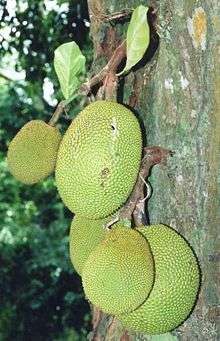Mushroom hunting

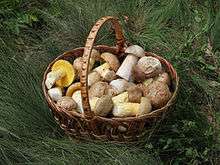
Mushroom hunting, mushrooming, mushroom picking, mushroom foraging, and similar terms describe the activity of gathering mushrooms in the wild, typically for eating. This is popular in most of Europe, including the Nordic, Baltic, and Slavic countries and the Mediterranean Basin, as well as in Australia, Japan, Korea, Canada, the Indian subcontinent, and the northwestern, northeastern, Midwestern and Appalachian United States.
Identifying mushrooms
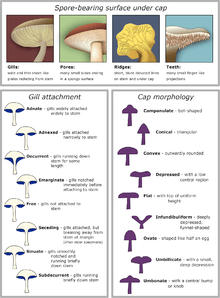
A large number of mushroom species are favored for eating by mushroom hunters. The king bolete is a popular delicacy. Sulphur shelf (also known as chicken mushroom and chicken of the woods) is often gathered because it occurs in bulk, recurs year after year, is easily identified, and has a wide variety of culinary uses. Pine mushrooms, chanterelles, morels, oyster mushrooms, puffballs and polypores are among the most popular types of mushrooms to gather, most of these being fairly simple to properly identify by anyone with practice. Much more care, education, and experience is typically required to make a positive identification of many species, however, and as such, few collect from more dangerous groups, such as Amanita, which include some of the most toxic mushrooms in existence.
Many field guides on mushrooms are available, but the ability to identify and prepare edible mushrooms is often passed down through generations, especially in the Slavic countries.
Identification is not the only element of mushroom hunting that takes practice; knowing where and when to search does as well. Most mushroom species require very specific conditions. Some only grow at the base of a certain type of tree, for example. Finding a desired species that is known to grow in a certain region can be a challenge.
Safety issues
A Czech adage warns that "všechny houby jsou jedlé, ale některé jenom jednou." Translated, that "every mushroom is edible, but some only once." Some mushrooms are deadly or extremely hazardous when consumed. Some that are not deadly can nevertheless cause permanent organ damage. The literature strongly advises:
- That only positively identified mushrooms should be eaten
- That mushrooms be identified a second time during preparation and to cook them unless it can be verified that the species can be eaten raw
- That mushroom types not be combined
- That a sample of any mushroom not well-experienced with be retained for analysis in case of poisoning
- Familiarity with information about deadly mushrooms that are look-alikes of edible ones, as "deadly twins" differ regionally.
- Not gathering mushrooms that are difficult to identify. This applies especially to the mushrooms of the genus Amanita and Cortinarius and "little brown mushrooms".
- Consuming only a small amount the first time a new species is tried. People react differently to different mushrooms, and all mushroom species can cause an adverse reaction in a few individuals, even the common champignon.[1]
Little brown mushrooms
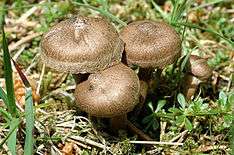
"Little brown mushrooms" (or LBMs) refers to any of a large number of small, dull-coloured agaric species, with few macromorphological uniquely distinguishing characteristics.[2] As a result, LBMs typically range from difficult to impossible for mushroom hunters to identify. Experienced mushroomers may discern more subtle identifying traits that help narrow the mushroom down to a particular genus or group of species, but exact identification of LBMs often requires close examination of microscopic characteristics plus a certain degree of familiarity or specialization in that particular group.
For mycologists, LBMs are the equivalent of LBJs ("little brown jobs") and DYCs ("damned yellow composites") that are the bane of ornithologists and botanists, respectively.
"Big white mushroom" (or BWM) is also sometimes used to describe groups of difficult to identify larger and paler agarics, many of which are in the genus Clitocybe.
Psychotropics
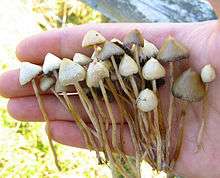
The Amanita muscaria's psychotropic properties have been traditionally used by shamans in Siberia in their rituals. However, its use for such purposes today is very rare, despite the mushroom's abundance. Instead, the Psilocybe semilanceata is sought after for its hallucinogenic properties, the latter being more desirable with fewer side effects than those of A. muscaria. The use of P. semilanceata is however significantly hindered by its small size, requiring larger quantities and being hard to spot. Other Psilocybe species are abundant in the American south and west, as well as Mexico, where they have been used by traditional shamans for centuries. In the west, one can often find mushroom pickers in cow pastures in a stereotypical stoop looking in the grass for psilocybes. This can be quite dangerous, as many species grow in pastures and amateurs often misidentify psilocybes.
- Amanita muscaria (Мухомор Красный [Mukhomor Krasniy] - Red Fly-Killer; Fly Agaric, Toadstool)
- Psilocybe semilanceata (Псилоциба Сосочковидная [Psilotsiba Sosochkovidnaya] - Nipple-Like Psylocybe; Liberty Cap)
Regional importance
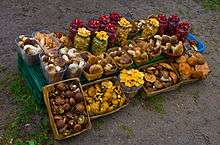
- In the United States mushroom picking is popular in the Appalachian area and on the west coast from San Francisco Bay northward, in northern California, Oregon and Washington, and in many other regions.
- British enthusiasts today enjoy an extended average picking season of 75 days compared to just 33 in the 1950s.[3]
- In Slavic countries and Baltic countries, mushroom picking is a common family activity. After a heavy rain during the mushroom season whole families often venture into the nearest forest, picking bucketfuls of mushrooms, which are cooked and eaten for dinner upon return (most often in omelettes with eggs or fried in butter) or alternatively dried or marinated for later consumption.
Festivals
The popularity of mushroom picking in some parts of the world has led to mushroom festivals. The festivals are usually between September and October, depending on the mushrooms available in a particular region. Festivals in North America include:
- Aerie Resort on Vancouver Island—Great Fall Mushroom Hunt
- Bamfield, Vancouver Island—Bamfield Mushroom festival
- Boyne City, Michigan—Annual National Morel Mushroom Festival[4]
- Buena Vista, Colorado—Buena Vista Heritage's Mushroom Festival
- Washington's Long Beach Peninsula—Wild Mushroom Celebration
- Lake Quinault Lodge in Washington's Olympic National Forest—Quinault Rain Forest Mushroom Festival
- Mendocino County (North of San Francisco)--Mushroom Festival
- Madisonville, Texas—Mushroom Festival[5]
- Telluride, Colorado—Telluride Mushroom Festival[6]
- Kennett Square, Pennsylvania—Mushroom Festival
- Girdwood, Alaska—Fungus Fair
- Muscoda, Wisconsin—Morel Mushroom Festival
- Eugene, Oregon—Mushroom Festival
- Richmond, Missouri—Mushroom Festival
- New Plymouth, Taranaki, New Zealand-Mushroom Ball
Radiation
Nuclear fallout from the Chernobyl disaster is an important issue concerning mushroom picking in Europe. Due to the wide spread of their mycelium, mushrooms tend to accumulate more radioactive caesium-137 than surrounding soil and other organisms. State agencies (e.g. Bellesrad in Belarus) monitor and analyze the degree of radionuclide accumulation in various wild species of plants and animals. In particular, Bellesrad claims that Svinushka (Paxillus ssp.), Maslenok (Suillus ssp.), Mokhovik (Xerocomus ssp.), and Horkushka (Lactarius rufus) are the worst ones in this respect. The safest one is Opyonok Osyenniy (Armillaria mellea). This is an issue not only in Poland, Belarus, Ukraine and Russia: the fallout also reached western Europe, and until recently the German government discouraged people gathering certain mushrooms.
The situation is treated with black humor in some Russian jokes.
Guidelines for mushroom picking
Poisonous mushrooms commonly confused with edible ones
Many mushroom guidebooks call attention to similarities between species, especially significant if an edible species is similar to, or commonly confused with, one that is potentially harmful.
Examples:
- False chanterelles (Hygrophoropsis aurantiaca), as the name suggests, can look like real chanterelles (Cantharellus cibarius) to the inexperienced eye. The latter do not have sharp gills, but rather blunt veins on the underside. Misidentification in this case is not likely to prove significantly dangerous, as false chanterelles are considered edible, but unpleasant tasting. Mild symptoms have been reported from consuming them.[7] Conversely, the Jack O'Lantern mushroom is often mistaken for a chanterelle, and it is potently toxic.
- True morels are distinguished from false morels (Gyromitra spp. and Verpa spp.). False morels have caps attached at the top of the stalk, while true morels have a honeycombed cap and a single, continuous hollow chamber within.
- Immature Chlorophyllum molybdites can be confused with edible Agaricus mushrooms.
- Immature puffballs are generally edible, but care must be taken to avoid species such as Scleroderma citrinum and immature Amanitas. These can be identified by cutting a puffball in half and looking for a dark reticulated gleba or the articulated, nonhomogeneous structures of a gilled mushroom, respectively.
- Highly poisonous Conocybe filaris and some Galerina species can resemble Psilocybe, and the species are observed growing alongside each other. Psilocybe species are not deadly but contain the alkaloids psilocybin and psilocin, known to cause hallucinogenic effects; therefore it is often sought for use as a recreational psychedelic drug.
Eating poisonous species
There are treatments to reduce or eliminate the toxicity of certain (but not all) poisonous species to the point where they may be edible.[8] For instance, false morels are deadly poisonous when eaten raw or incorrectly prepared, but their toxins can be reduced by a proper method of parboiling. Prepared in this way, this mushroom is widely used and considered a delicacy in many European countries, although recent research suggests that there may still be long-term health consequences from eating it.[9]
Commonly gathered mushrooms

Commonly gathered species, grouped by their order taxa, are as follows: mushroom species mentioned in each group are listed at the end of the paragraph using the following convention: Latin name (common English names, if any).
Agaricaceae
The Macrolepiota genus, usually the Macrolepiota procera, and, to a lesser extent, the M. rhacodes are highly regarded, especially in Europe, being very palatable and very large, with specimens of M. procera as high as one metre being reported.
- Agaricus bisporus also known as the table or button mushroom. Sales of this mushroom in 1996 reached $209 million in Canada.[10] Another well known mushroom known as the portobello is a large brown strain of this fungus.
- Coprinus comatus (shaggy ink cap) decomposes into ink, and hence are prepared soon after picking and only young specimens are collected. While being a general mushroom hunting guideline, the avoidance of specimens growing in areas with high pollution is especially important with this family, as it is a very effective pollutant absorber.
- Macrolepiota procera (parasol mushroom)
Amanitaceae
While the family of Amanitas are approached with extreme caution, as it contains the lethal Amanita phalloides and Amanita virosa, those confident in their skills often pick the Amanita rubescens, which is highly prized in Europe and to a much lesser extent in Russia, accounted by some not to superior taste, but to its relation to the Amanita caesarea, which is not found in Russia, but was considered a delicacy worthy of the emperor in Ancient Rome.
- Amanita rubescens (European blusher)
- Amanita caesarea (Caesar's mushroom)
Boletaceae
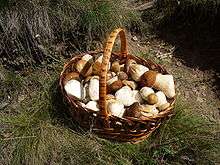
This order is often viewed as the order of "noble" mushrooms, containing few poisonous species, identifiable with relative ease, and having superior palatability. The most notable species is the Boletus edulis, the "mushroom king", an almost legendary, relatively rare mushroom, edible in almost any (even raw) form, and commonly considered the best-tasting mushroom. (It is common to confuse the Russian name, literally "white mushroom", with champignons, often known in English as "white mushrooms".)
- Boletus edulis (Hřib Smrkový, Dubák, Borowik szlachetny, Porcino, King Bolete, Cep, Steinpilz)
The Leccinum genus includes two well-known mushroom species named after the trees they can usually be found next to. The Leccinum aurantiacum (as well as the Leccinum versipelle), found under aspen trees, and the Leccinum scabrum (as well as the L. holopus), found under birch trees. The secondary mentioned species, are significantly different in cap colour only. Both types are very sought after, being highly palatable, while more common than the B. edulis.
- Leccinum aurantiacum (red-capped scaber stalk)
- Leccinum scabrum (birch bolete)
The Suillus genus, characterised by its slimy cap, is another prized mushroom, the Suillus luteus and Suillus granulatus being its most common varieties, and while abundant in some parts of Eurasia, is a rare occurrence in others. It is easy to identify and very palatable.
- Suillus (klouzek, slippery Jack, butter mushroom)
The Xerocomus genus is generally considered a less desirable (though mostly edible) mushroom group, due to common abundant mould growth on their caps, which can make them poisonous. The Xerocomus badius, however is an exception, being moderately sought after, especially in Europe. Some scientific classifications now consider species in the Xerocomus genus as members of Boletus.
- Xerocomus (mossiness mushroom)
- Xerocomus badius (hřib hnědý)
Cantharellaceae
The Cantharellus cibarius, a common and popular mushroom, especially in Europe, is a choice edible and unique mushroom. It is very rarely infested by worms or larvae, has a unique appearance, and when rotting, the decomposed parts are easily distinguishable and separable from those that are edible.
- Cantharellus cibarius (chanterelle, yellow chanterelle, pfifferling)
Helvellaceae
The Gyromitra esculenta is considered poisonous, but can be consumed if dried and stored for over a year, according to Slavic literature, and can be used to supplement or replace morel (see Morchellaceae below) mushrooms, while Western literature claims that even the fumes of the mushroom are dangerous. It is similar to morels both in appearance and palatability.
- Gyromitra esculenta (false morel, beefsteak morel, lorchel)
Morchellaceae
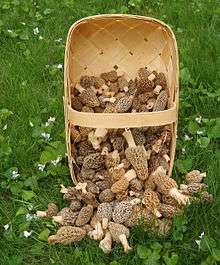
The morel, Morchella esculenta is highly prized in Western Europe, India and North America. It is significantly less prized in Slavic countries where, like the Gyromitra esculenta, is considered marginally edible with mediocre palatability. Boiling the mushroom and discarding the water is often recommended.
- Morchella esculenta (morel, yellow morel)
Lactarius
Members of the genus Lactarius, as the name suggests, lactate a milky liquid when wounded and are often scoffed upon by Western literature. The Lactarius deliciosus is however regarded as one of the most palatable mushrooms in Slavic culture, comparable to the Boletus edulis. Also considered as similarly palatable are the species Lactarius necator and particularly Lactarius resimus. Thermal treatment may however be necessary in some cases. Slightly less appealing due to its bitter taste is the Lactarius pubescens.
- Lactarius deliciosus (saffron milk-cap)
- Lactarius resimus (pepper cap)
- Lactarius necator (black pepper cap)
- Lactarius pubescens (wooly milk-cap)
Russulaceae
The Russula family includes over 750 species and is one of the most common and abundant mushrooms in Eurasia. Their cap colours include red, brown, yellow, blue and green and can be easily spotted. The Russula vesca species, one of the many red-capped varieties, is one of the most common, is reasonably palatable and can be eaten raw. The edible Russulas have a mild taste, compared to many inedible or poisonous species that have a strong hot or bitter taste. The Russula emetica (the sickener) is known to cause gastrointestinal upset and has a very hot taste when a small bit is placed on the tongue. Due to their abundance they are however often regarded as an inferior mushroom for hunting, since they may be eaten if parboiled.
- Russula vesca (Russula)
Tricholomataceae
- Armillaria (honey mushroom, shoestring rot). The genus Armillaria, with the popular species A. gallica and A. mellea, being so similar that they are rarely differentiated, are palatable, highly abundant mushrooms. Generally found on decaying tree stumps, they grow in very large quantities and are easy to spot and identify, arguably reducing the fun and challenge in mushroom hunting.
- Pleurotus ostreatus (oyster mushroom). It is the most commonly picked tree-dwelling mushroom and is often also artificially cultivated for sale in grocery stores. This sturdy mushroom can be quite palatable when young. Growing these mushrooms at home can be a profitable enterprise and some Russians engage in the activity.
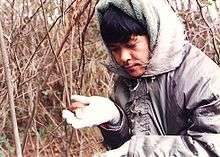
- Tricholoma matsutake - = syn. T. nauseosum, the rare red pine mushroom that has a very fine aroma. Its fragrance is both sweet and spicy. They grow under trees and are usually concealed under fallen leaves and the duff layer. It forms a symbiotic relationship with the roots of a limited number of tree species. In Japan it is most commonly associated with Japanese red pine. However, in the Pacific Northwest it is found in coniferous forests of Douglas fir, noble fir, sugar pine, and Ponderosa pine. Farther south, it is also associated with hardwoods, namely tanoak and madrone forests. The Pacific Northwest and other similar temperate regions along the Pacific Rim also hold great habitat producing these and other quality wild mushrooms. In 1999, N. Bergius and E. Danell reported that Swedish (Tricholoma nauseosum) and Japanese matsutake (T. matsutake) are the same species. The report caused the increased import from Northern Europe to Japan because of the comparable flavor and taste. Matsutake are difficult to find and are therefore very expensive. Moreover, domestic productions of Matsutake in Japan have been sharply reduced over the last fifty years due to a pine nematode Bursaphelenchus xylophilus, and it has influenced the price a great deal. The annual harvest of matsutake in Japan has since further decreased. The price for matsutake in the Japanese market is highly dependent on quality, availability and origin. The Japanese matsutake at the beginning of the season, which is the highest grade, can go up to $2000 per kilogram, while the average value for imported matsutake from China, Europe, and the United States is only about $90 per kilogram.[11]
- The Tricholoma magnivelare is a prized mushroom in North America. British Columbia exports large quantities of this mushroom overseas to Asia where it is in high demand.[12]
See also
References
- ↑ Ho, Marco H. K.; Hill, David J. (2006). "White button mushroom food hypersensitivity in a child". Journal of Paediatrics and Child Health. 42 (9): 555–556. doi:10.1111/j.1440-1754.2006.00922.x.
- ↑ IMA Glossary: LBM
- ↑ Gange, A. C.; Gange, E. G.; Sparks, T. H.; Boddy, L. (2007). "Rapid and recent changes in fungal fruiting patterns". Science. 317 (5821): 71. doi:10.1126/science.1137489.
- ↑ http://www.morelfest.com/
- ↑ http://www.texasmushroomfestival.com/
- ↑ http://www.telluridemushroomfest.org/
- ↑ Arora, David. Mushrooms Demystified. Ten Speed Press, 1986
- ↑
- ↑ Michael W. Beug, Marilyn Shaw, and Kenneth W. Cochran. Thirty plus Years of Mushroom Poisoning: Summary of the Approximately 2,000 Reports in the NAMA Case Registry.
- ↑ Hans E. Gruen
- ↑ Finding and Preparing The Elusive Matsutake Mushroom
- ↑ Tom Volk's Fungus of the Month for September 2000
Further reading
- Edible and Medicinal Mushrooms of New England and Eastern Canada (2009) ISBN 978-1-55643-795-3 (1-55643-795-1)
- Edible Wild Mushrooms of North America: A Field-to-kitchen Guide (1992) ISBN 978-0-292-72080-0
- Mushrooms of Northeastern North America (1997) ISBN 0-8156-0388-6
- All That the Rain Promises, and More (1991) ISBN 0-89815-388-3
- Mushrooms Demystified: A Comprehensive Guide to the Fleshy Fungi (1986) ISBN 0-89815-169-4
- 100 Edible Mushrooms: With Tested Recipes(2007) ISBN 0-472-03126-0
- North American Mushrooms: A Field Guide to Edible and Inedible Fungi (2006) ISBN 0-7627-3109-5
- How to Identify Edible Mushrooms (2007) ISBN 0-00-725961-1
- Mushrooming Without Fear (2007) ISBN 1-60239-160-2
- The Mushroom Rainbow: Only the most delicious or deadly mushrooms sorted by color (2011) ISBN 978-0-9869409-0-3 (0986940909)
External links
- The Mushroom Forager
- Mushroom database
- Bill O'Dea Mushroom hunts and festivals in Ireland, Europe and Turkey
- Mushroom-collecting.com — A Maine and New England Edible and Medicinal Mushroom Resource
- Polish Mushroom Hunters Club - Photos, Find reports etc.
- David Fischer's AmericanMushrooms.com
- Current Mushroom Find Reports With Photos
- Mushroom descriptive fields
- List of North American Mycological Societies
- A finnish amateur site with photos (partly in English)
- Fungi of Kaluga region (Russian) — Site of Russian mushroom hunter with a lot of photos (with titles in English).
- Mushrooms found in continental climate areas of Russia (Russian)
- MushroomExpert.com
- Czech amateur site with photos (Czech)
- Canadian Government Mushroom Picking Site
